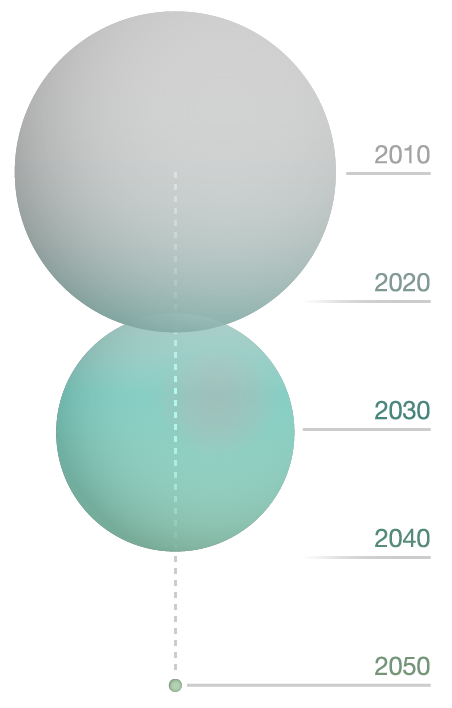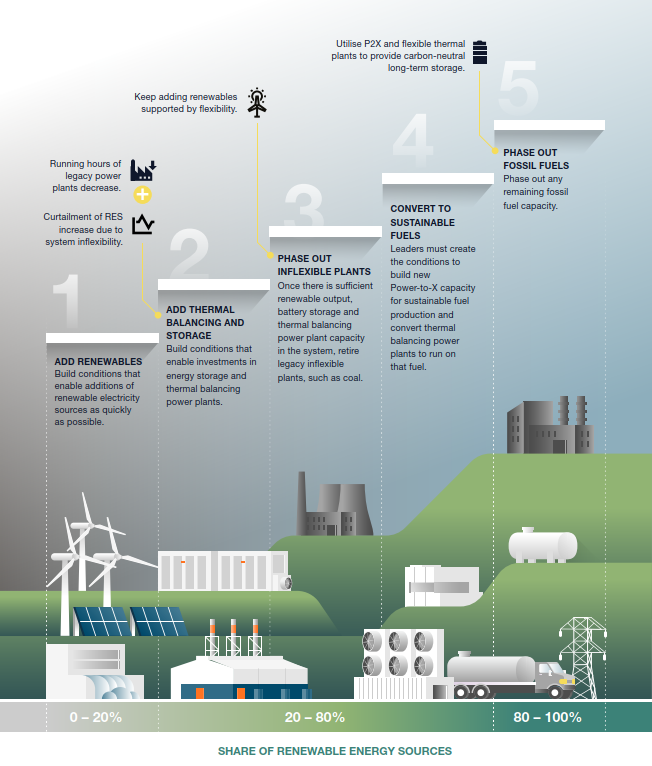
The time to decarbonise is now
The latest Intergovernmental Panel of Climate Change (IPCC) report from 2021 finds that unless there are immediate, rapid and large-scale reductions in greenhouse gas emissions, the opportunity to limit warming to close to 1.5 °C or even 2 °C will slip beyond our reach. It is paramount that we globally invest in decarbonisation of our optimised energy consumption, which has been fully embraced by energy leaders. The evolving regulatory landscapes need to push for viable sustainable investments that decarbonise the entire system.
Decarbonisation is feasible with current technologies – and does not cost more
Wärtsilä modelling results (see our Front-loading Net Zero report) show that the transition from fossil-based (e.g. coal) to 100% carbon-neutral electricity generation will not increase the cost of electricity in comparison to today.
TO LIMIT GLOBAL WARMING TO 1.5 °C, GLOBAL CO2 EMISSIONS SHOULD DECLINE BY 45% BY 2030 IN COMPARISON TO 2010 AND REACH NET ZERO BY 2050.

Currently, power generation is undergoing a rapid transformation towards cleaner energy sources due to huge additions of low-cost renewable electricity (wind and solar). To ensure a reliable and secure supply of electricity both short-term and long-term balancing is needed. The rapidly maturing battery storage technologies give great benefits short term. And there is a clear vision for the last piece of the decarbonisation puzzle: The Power-to-X-to-Power (P2X2P) concept, which enables long-term energy storage.
P2X2P turns excess and low-priced renewable electricity via electrolysis into hydrogen. This hydrogen is stored and converted back to electricity by balancing power plants when needed.
As wind and solar become the norm their intermittent character requires balancing thermal power to ensure adequate electricity during longer foreseen or sudden renewable “droughts” (no wind or sunshine). The running hours for thermal power plants will substantially decrease – long gone will be the days of only baseload operations. More dynamic operations are required overall. The positive effect is not limited to the total fuel consumption and costs to decrease but the GHG emissions reduction will be significant on system level.
It’s important to use all available low-carbon fuels in the future energy mix to decarbonise the power generation sector and to gradually phase out the most carbon-intensive fuels by using natural gas as a bridge. Furthermore, biofuels and biogas can already be used to decarbonise thermal combustion – locally where available. By closing inflexible fossil assets and when flexible gas generation is converted to sustainable fuels the final push of decarbonisation of the energy generation is reached.
![]() IN SIMPLIFIED TERMS, THE
CAPITAL INVESTMENTS
NEEDED IN NEW RENEWABLE
ELECTRICITY GENERATION
OUTPUT AND IN BALANCING
POWER TO DEAL WITH
RENEWABLE ELECTRICITY
INTERMITTENCY ARE MORE THAN OFFSET BY THE
SAVINGS IN FOSSIL FUEL USE.
IN SIMPLIFIED TERMS, THE
CAPITAL INVESTMENTS
NEEDED IN NEW RENEWABLE
ELECTRICITY GENERATION
OUTPUT AND IN BALANCING
POWER TO DEAL WITH
RENEWABLE ELECTRICITY
INTERMITTENCY ARE MORE THAN OFFSET BY THE
SAVINGS IN FOSSIL FUEL USE.
The key steps to front-load net zero

1. Add renewables: Build conditions that enable additions of renewable electricity sources as quickly as possible.
2. Add thermal balancing and storage: Build conditions that enable investments in energy storage and thermal balancing power plants.
3. Phase out inflexible plants: Once there is sufficient renewable output, battery storage and thermal balancing power plant capacity in the system, retire legacy inflexible plants, such as coal.
4. Convert to sustainable fuels: Leaders must create the conditions to build new Power-to-X capacity for sustainable fuel production and convert thermal balancing power plants to run on that fuel.
5. Phase out fossil fuels: Phase out any remaining fossil fuel capacity.
